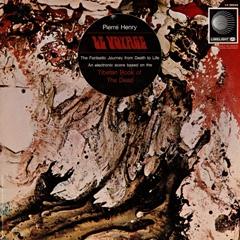Pierre Henry – Le Voyage - D'après Le Livre Des Morts Tibétain (1967)
Pierre Henry – Le Voyage - D'après Le Livre Des Morts Tibétain (1967)

A1 Souffle 1 7:07 A2 Après La Mort 1 (Fluide Et Mobilité D'un Larsen) 9:44 A3 Après La Mort 2 (Mouvement En 6 Parties) 7:33 B1 Divinités Paisibles 9:18 B2 Divinités Irritées 3:41 B3 Le Couple 6:50 B4 Souffle 2 5:02 Based on the Tibetan Book of the Dead. Tracks created on 25th June 1963 at Eglise Saint-Julien-le-Pauvre. Pierre Henry - Synthesizer
“…The term “Musique Concrete” was coined by [Pierre] Schaeffer to describe the music that he and [Pierre] Henry (& others) were creating from Natural Sources; such sounds as industrial and traffic noises, sounds of nature, sounds produced by musical instruments and the human voice, etc., were tape-recorded and then altered by re-recording them backwards, through filters, at different speeds, with echo effects, and so on. While Henry and Shaeffer were producing their first experimental works, the West German Radio founded a similar research studio in Cologne. This studio differed from that of the R.T.F. [Radio-Diffusion Television Francaise; with whom Henry & Schaeffer were associated] in that Sinetone Generators were installed to produce “Sinusoidal” sound – i.e., pure tones, without any overtones. This variety of tape music employed by such composers as Eimert and Stockhausen, became simply known as “Electronic Music.” By 1958, when Henry left the R.T.F. to set up his own studio (The Studio Apsome), the terms “Musique Concrete” and “Electronic Music” were beginning to fuse, as electronically produced sounds were being mixed with “concrete” sounds both in France and in Germany, and in the new Italian and American studios.
In 1955 Henry met Maurice Bejart, a choreographer who was using”musique concrete” to accompany experimental ballets that he created. Encouraged by Bejart, Henry composed for him Le Voyage (The Voyage), based on The Tibetan Book of the Dead. The work was first heard on April 15, 1962, in Cologne; but Henry produced another version in The Church of St. Julian-le-Pauvre in Paris on June 25…1963…And it is the second version that we hear on this recording.
Now, The Tibetan Book of the Dead, which first appeared in English in 1927, is used as a breviary, to be read or recited on the occasion of death to help the dying man concentrate on the experience he is about to undergo, and to give him instruction in the cycle of events after death which lead either to liberation or reincarnation. In highly symbolic language, the dead man’s spirit is told what to expect in each of the three stages between death and rebirth. The first stage describes the psychic happening at the moment of death; the second stage describes the dream-state which follows and the “karmic” illusions which occur; and the third step describes the beginnings of pre-natal feelings.
…Hearing is perhaps the last faculty to remain. The ears of the dying man are filled with the final clamorings of earthly life: thousands of whispering voices, motor cars, marine trumpets, torture applied to the teeth, the hands, the sudden agony of the radio. And a wind, a wind that comes nearer, and which he recognizes as the sound of his own breathing. By his side is the lama, the priest, or the friend.” --- ghostcapital.org
download (mp3 @320 kbs):
yandex 4shared mega mediafire cloudmailru uplea ge.tt








